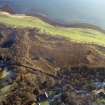Golspie, Golspie Mills
Watermill (19th Century)
Site Name Golspie, Golspie Mills
Classification Watermill (19th Century)
Alternative Name(s) Golspie Mill; Meal Mill; Corn Mills; Flour Mill
Canmore ID 6584
Site Number NC80SW 31
NGR NC 84110 00636
Datum OSGB36 - NGR
Permalink http://canmore.org.uk/site/6584
- Council Highland
- Parish Golspie
- Former Region Highland
- Former District Sutherland
- Former County Sutherland
NC80SW 31 84110 00636
See NMRS, MS/500/35/47.
(Location cited as NC 841 007). Golspie Mill, probably built in the early 1820s. A fine 3-storey, 5-bay, sandstone-rubble building with a large kiln projection at the rear. The wood and iron and spoked overshot wheel, by James Abernethy, Aberdeen, is 12ft 8in diameter by 5ft 8in wide (3.86 by 1.72m) and drove 4 pairs of stones and a pot-barley mill. The largest mill in Sutherland, it closed in 1935.
J R Hume 1977.
Publication Account (1995)
The largest mill in Sutherland, it was built for the Duke of Sutherland in 1863 to replace an older mill. It shut down in 1953 but has re-opened after careful restoration. It is a solid, L-shaped, three-storey stone building, plain but enlivened by crow-stepped gables. The large kiln with a louvred vent in its roof is in the wing behind. The mill windows have the traditional fixed glazing above and opening wooden shutters below, while much of the interior woodwork and machinery is original. The overshot wood and iron water-wheel drives three pairs of millstones and a pot barley mill. The latter (which made pot or pearl barley for soup and so on) is a large single millstone mounted vertically in a wire cage, and it polished the outer coat of the barley packed round it.
On the ground floor there is an office with firep lace and sash windows, which is partitioned off at the west end. The millstones and a rotating sieve for oatmeal are on the first floor, and on the second are the metal doors to the drying kiln, which was fuelled originally by chaff (husks') separated from the grain, and later by coke from Golspie Gas Works. Almost all jobs, such as raising or lowering sacks, can be done by water-power and the will can now be run single-handed.
A detailed specification exists for the erection of the meal mill in 1863. It refers to the cast iron pillars which support the upper floors, the wall stones which were to come from the Backies Quarry behind Golspie (though some stone from the old mill could be used for the inside of the walls), Caithness 'pavement' (see no. 15) for the floor, and iron latches and locks to the mill and office 'all of the best quality'. The contractor was asked to estimate for Burlington slate, Ballachulish slate and Welsh slate, and the ridge tiles were to come from lnvernettie Brickworks near Peterhead. The present millwheel made by james Abernethy & Co of Aberdeen may be a later replacement. The original gears survive; one iron cog wheel has 104 wooden teeth which were repaired by a coach builder in Golspie.
There were two large mills here in the 19th century. The meal mill was for oats, making oatmeal, and the flour mill for wheat, making finer flour. The ruins of the four-storey flour mill are in the angle of the burn and bridge. Just by it is the old bridge of 1808, now by-passed; it has an obelisk carved with a Gaelic inscription on its parapet. Behind the meal mill are two mill-worker's cottages, probably of the same date (not open), and the mill pond, fed by a lade from higher up the burn. The various kinds of flour produced are sold on the premises. Visitors can walk round on all floors with a tape commentary while the miller works. The mill is open in the afternoon, mid-June to mid-September.
Information from ‘Exploring Scotland’s Heritage: The Highlands’, (1995).
External Reference (2010)
There were two mills at the site. The first was built in 1816 by the Countess of Sutherland to grind grain and wheat grown in the area. In 1863 another mill was built to grind oats and bere. This later mill was fully restored in 1992 and still operates today. The first mill was closed in 1922.
Research by Beryl Nicol, ARCH Community Timelines course 2010, based on papers from the mill, now in Golspie Heritage Society


































































